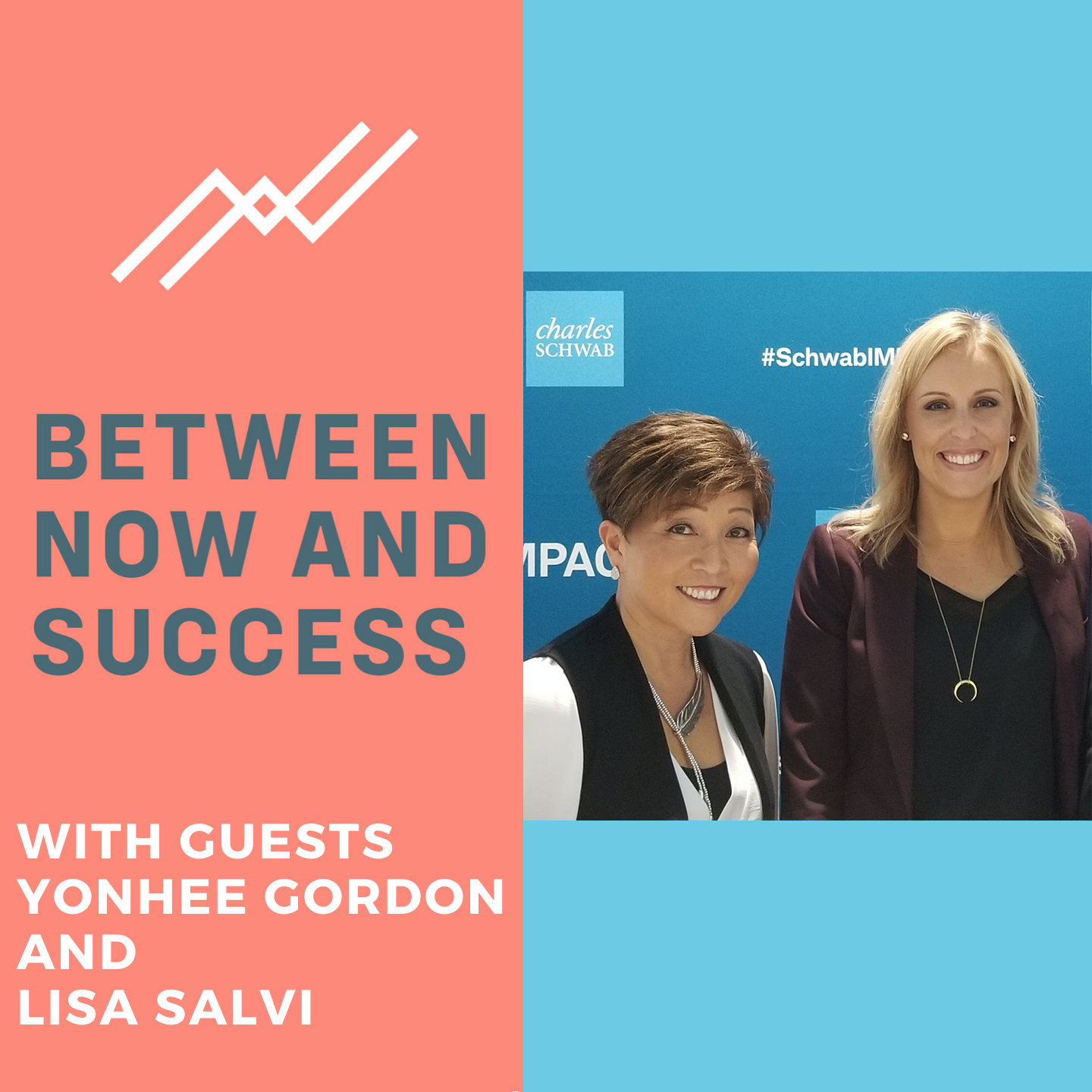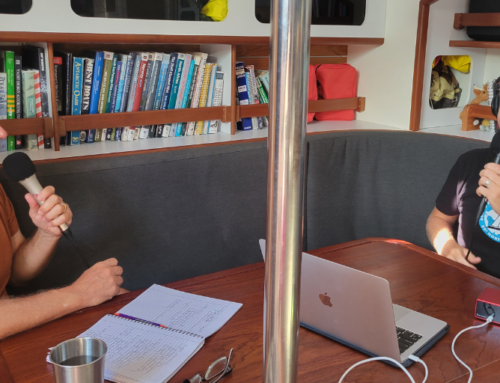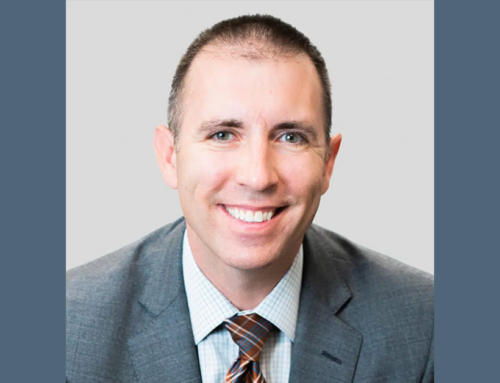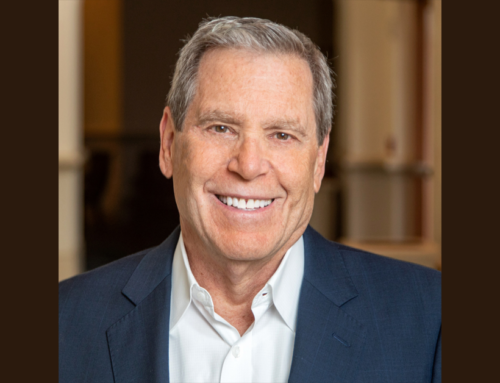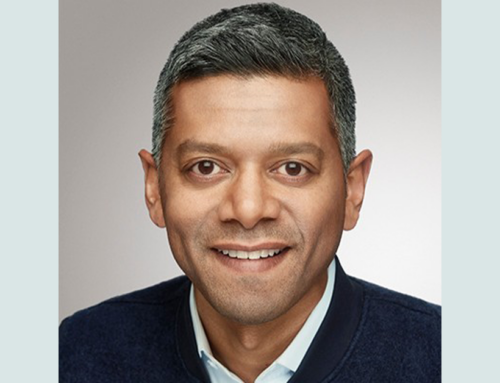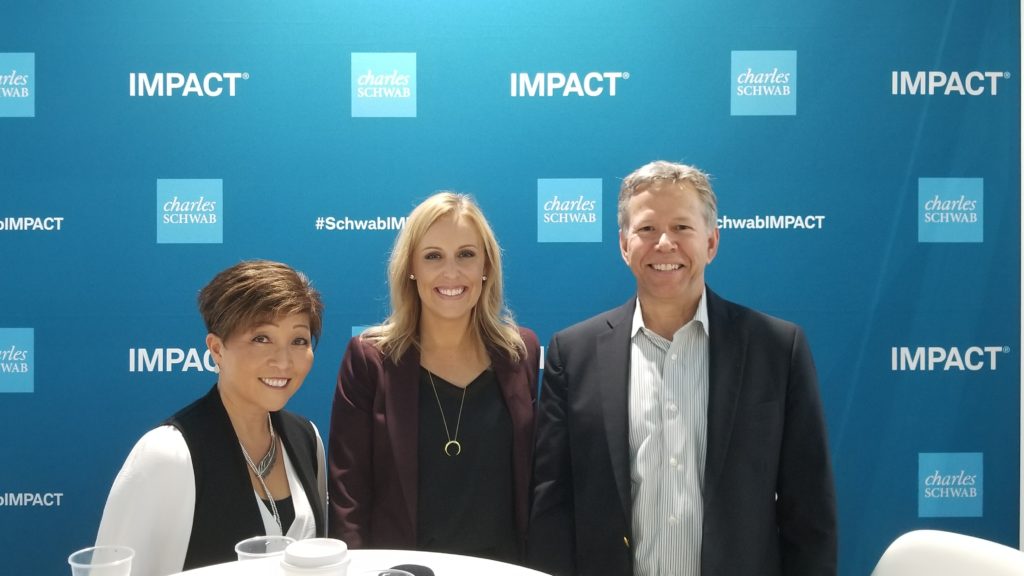
Yonhee Gordon, Lisa Salvi, and Steve Sanduski, CFP®.
In a Nutshell: Clear career paths and offering a path to partnership and equity ownership are key ways to attract and retain next generation advisors and advisory firm leaders.
Guests: Lisa Salvi is Vice President of Advisor Services at Charles Schwab, where she oversees business consulting and education offerings, including their one-on-one consulting engagements, the annual RIA Benchmarking Study, and other programs that support the development of advisor talent.
Yonhee Gordon is a principal and Chief Operating Officer of JMG Financial Group just outside of Chicago, which has more than $3.0 billion in assets under management.
My Key Takeaway: If you want to win the battle for top talent:
- Define clear career tracks for top employees.
- Offer your absolute best people partnership and equity ownership opportunities.
- Incorporate those paths and ownership opportunities into your succession planning so that your firm can continue to succeed once you kick back.
Also Learn
1. Why you should consider extending some of your best incentive packages to key non-revenue-earning personnel.
2. How a path to promotion led Yonhee Gordon from an entry-level position with JMG all the way up to COO and Partner.
3. What the Schwab 2019 RIA Benchmarking Study says about the state of our industry.
Complementary Episode: Pair this with my 2018 episode from Schwab Impact in which Lisa discussed Schwab’s Guiding Principles for Advisory Firm Success along with Mitch Reiner of Capital Investment Advisors. Listen/read here.
Resources Featured in This Episode
Charles Schwab 2019 RIA Benchmarking Study
Charles Schwab Owning the Future of Independent Advice Report, in which Yonhee participated.
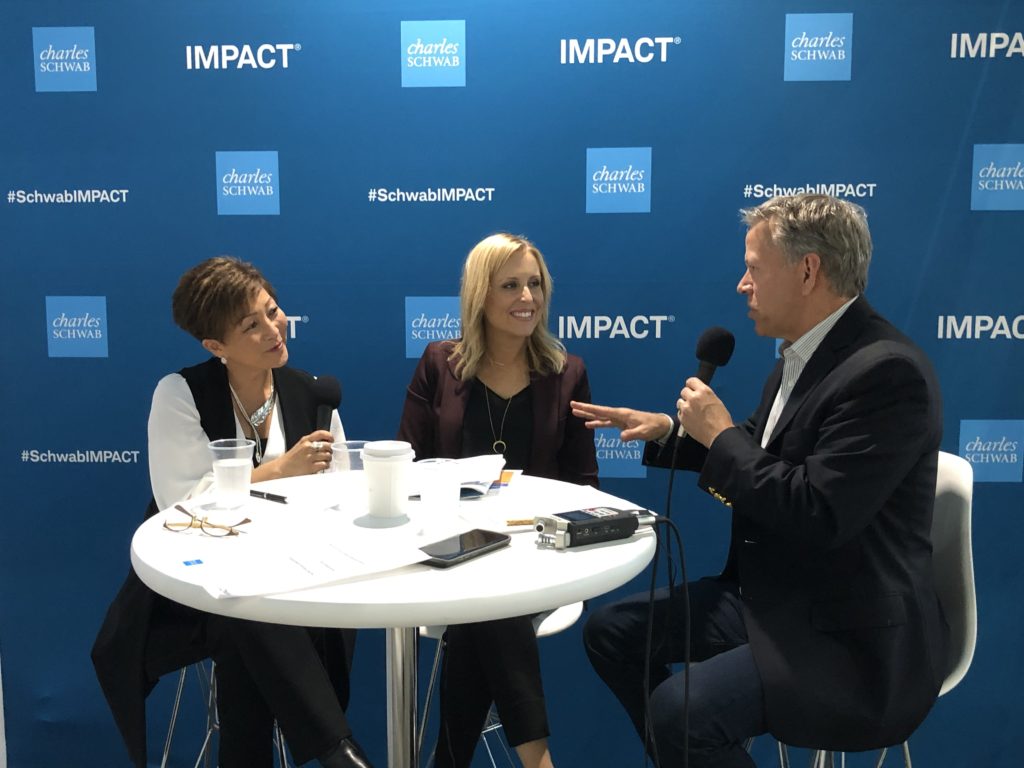
Yonhee Gordon, Lisa Salvi, and Steve Sanduski, CFP® live from Schwab Impact 2019.
Values Clarification Toolkit Click here to download this FREE tool and start living your values.
Full Transcript
Steve Sanduski: Lisa, why don’t we go ahead and start with you. And why don’t you set some context here for what is happening in the RIA industry. I know Schwab comes out with their annual benchmarking study, so we’ve got some good data on how the industry is going. Why don’t we start with some context and then we’ll go into some specifics about how do advisors and advisory firms attract and retain top talent?
Lisa Salvi: Great. Thank you so much Steve. I’m very excited to be here with you again. Last time we spoke I was talking about benchmarking results and also our guiding principles for advisory firm success. And we’ve continued to see through benchmarking that this industry is still experiencing tremendous growth.
Lisa Salvi: Even though we had a little bit of bumpiness at the end of last year in terms of the markets, we still have a 7.5% median CAGR in terms of AUM growth. But then metric that a lot of firms are really starting to focus in on is revenue. And that revenue growth of our five year period has been 9.4% which is pretty, pretty tremendous.
Lisa Salvi: So from five years ago at the median was making 2.7 million in revenue and today 4.2 million in revenue. And so when you think of that amount of growth, the number of new client relationships and then the talent that you need to serve that, it’s a pretty big change that firms are going through fairly rapidly.
Steve Sanduski: Right. And in this environment with the economy doing reasonably well, RIA firms are growing reasonably fast. It’s hard to find top people. So we’ve got to be more creative in the ways that we’re attracting them and keeping them on board.
Lisa Salvi: That’s right. One of the major conversations that I’m having here at Impact is just firms grappling with not being able to find enough talent to hire fast enough to keep up with that growth. Last year, 71% of firms hired at the media and they hired three roles, which is fairly significant for the size of firms we’re talking about.
To view the rest of the transcript, please enter your email address to unlock the content.
Lisa Salvi: And when we asked them going into 2019 how much hiring do you think you’re going to do? 76% said they were going to hire again. So we know this is a very big issue. We invite students to Impact every year. We’re trying to make those connections. We have 17 different universities here.
Lisa Salvi: We try to really spread the word about the phenomenal industry of the RA industry. So that more young people want to go in and are really highly trained when they enter into an advisory firm. But it continues to be a very big part of the conversation, when you talk to advisors about what’s on their mind for the future
Steve Sanduski: And is a lot of this hiring coming from one advisory firm poaching from another one or are we just getting new talent that are new to the industry?
Lisa Salvi: It’s both. I’m seeing more advisors are open to even hiring people outside of maybe a strict financial planning background. But that metric around how many advisors are hiring from other advisory firms where we’ve been watching that for a few years now. Five years ago, 32% of firms were hiring from other RAS, today it’s 42%.
Lisa Salvi: And when I talk to advisors, I can always tell which side of the equation they’re on by if that makes them really happy, because they’re getting some really great talent. Or if it makes them a little nervous because they’re the ones that are losing the talent. And we did a little bit of analysis to dig into that just a little bit more this year. And 73% of firms that are hiring from other advisors offer equity.
Lisa Salvi: And even though that doesn’t mean they’re offering a junior person equity on day one, they know that that’s part of their value proposition. And people are really attracted to firms that are growing, that have that opportunity and have the potential for sharing equity down the line.
Steve Sanduski: Well, I know it would be premature to say that the RIA industry is a mature industry, but we’re now probably on the second and in some cases the third generation of owners of firm. So Yonhee, I want to get your perspective. You have I think a unique perspective because you started off at your firm in basically an entry level role. And you’ve worked your way all the way up. So tell me that story?
Yonhee Gordon: Yes, I feel so old when you say it that way. But it’s really taught me a lot. Actually my journey and my story, I started out entry level. I actually started it in the insurance industry and when I was told after I got my licensing, okay, let’s make a list of your friends and family and sell them whole life policies. And I quickly realized that that was not what I wanted to do.
Yonhee Gordon: So just by chance I ran into an old Sunday school teacher of mine who became my mentor, who had just started at this firm. He gave me a chance and he gave me an opportunity to learn from the ground up. I had to teach myself a lot of things. And all those lessons learned have helped me in my journey today.
Yonhee Gordon: So when we started, really financial planning was very new in the early 80s and it was more so limited partnerships were big. We did tax returns. So I had to learn how to input onto a 10-40. I learned how to conduct an audit, which I had no idea what that was. But that was all part of it. And so as our firm evolved, I had the opportunity to progress and become an advisor and pave the way.
Yonhee Gordon: And I think I made the firm realize that we can promote from within the organization and let’s train our younger people. And I had been there a long time and I learned the systems. They start to understand the skills that I have. I learned from all the leaders in management. And so that’s what we do today.
Yonhee Gordon: And so one of the things, I’ve been at the firm for 33 years now and I look back and what a privilege it has been for me to be with my clients for that long. To also be a part of their life and every financial stage of their life. Seeing how they prepared for retirement as a staff person and then becoming their advisor during their retirement. And now unfortunately as they’re aging, seeing how the estate plan has come into play and dealing now with their family.
Yonhee Gordon: And that’s really what it’s all about. And I really view it as a privilege, very gratifying career for me. As our firm has grown, I think the talent retention, I think training, managing expectations, those are all key elements to our success. We’ve grown organically. One of the things I’m super proud of is our tenure of our advisors. We have 17 advisors.
Yonhee Gordon: Over 70% of them have all come up from an entry level position. Their average tenure is 19 years with our firm. And then we also, to Lisa’s point about equity ownership, we also offer that too. And we have a career path for that as well. So of our owners, we have 14 owners. The average tenure of them is about 24 years with the firm. So whatever we’re working on it seems to be working.
Steve Sanduski: Right. We were talking before we started our conversation here that we’re recording. You mentioned, you start off basically as an entry level and that at some point you made a shift to management. Tell me about that shift from going from an advisor full-time to now going into management. What was that like?
Yonhee Gordon: Yes. I really did that for personal reasons. I had two young children at the time and back then I’m really aging myself. But back then we had no internet. We didn’t have these fancy mobile devices that I could get emails and I had to be in the office. We had no way to work remotely and I wanted to maintain my career.
Yonhee Gordon: So when our vice president of administration decided to retire, she had been with us since day one. They asked me if I would be interested in moving to management. And it was really a personal decision because I wanted to maintain a career but also my children and having to be there for the clients. It was a bit much, even though my husband is very supportive. So for all those reasons, I decided to make that change into management.
Yonhee Gordon: Now looking back, probably the best thing for me and for the firm because I had done every position and in my role now, it’s a very unique position because I know what it’s like to be an advisor. I also know what it’s like to be a staff person. So in the developing of our employees, I could really focus on the different skills and the emotional intelligence.
Yonhee Gordon: That’s intelligence that’s required all those things. So I can speak the languages of all the different positions. And I think that’s what makes it unique for me.
Steve Sanduski: And your firm has several billion dollars in assets under management. And so were talking earlier too about how you really have an enterprise and one of the marks of an enterprise is the ability to go from an advisor led firm, where they’re still functioning as an advisor and they’re spending part-time trying to run the company versus putting professional level management in.
Steve Sanduski: And so your firm has made that shift. You’re one of the professional managers of the firm now who also has the experience of being an advisor. So you’ve really seen it from both sides. I want to get into some detail here in terms of the equity ownership part. And Lisa I’d like to have you share some of the context in terms of what has the benchmarking shown?
Steve Sanduski: What is Schwab’s research shown in terms of how RIA firms are thinking about equity ownership. Do many firms offer equity ownership right now? How sophisticated are they in having a documented process and a path to that?
Lisa Salvi: So this year we did a deep dive on this very question because it’s so important for our industry. And we definitely found that there’s a correlation between firm size and how much equity they share just as you would expect. So in the 100 to $250 million AUM range, it’s about 52% of firms are sharing equity with non founders.
Lisa Salvi: When you get up above $1 billion, that goes all the way up to about 83%. So as firms grow in complexity, just like Yonhee has been describing and they need more professional management and specialized roles. You definitely see more willingness to share equity with non founders. Across firms of all sizes, about 29% are not sharing equity with non founders.
Lisa Salvi: The other really interesting question we asked this year was around who makes the primary decisions within your firm. And above $1 billion in assets under management it’s a lot more people are sharing the leadership responsibility in terms of that very question. So they’re about 40% of those firms are not led primarily anymore by the founder.
Lisa Salvi: So there’s the equity ownership piece but also the leadership transition. Often those two things come together but not always. And that’s one of the things as we’ve done a pretty significant piece of research into equity ownership and how firms can evolve their equity ownership program.
Lisa Salvi: That’s a really important clarification to make because that can be one of the major areas where different expectations can set you up for a little bit of questions or problems. If a founder or the first generation of leader is crystal clear about whether or not they’re sharing decision making, do you have a seat at the table?
Lisa Salvi: What does it mean to be an equity owner at 2% or 5% or 15% and the next generation understands that expectation as well and it’s clear from day one, we see a lot more success with those initial versions of those models.
Steve Sanduski: Yeah, I think that’s such a great point that you can have a difference between I own some equity, but that doesn’t mean I’m going to have a seat at the table as you mentioned. So that’s important to get that out there, that communication really clear. I think that’s important.
Steve Sanduski: Now for these firms that do share equity ownership, is it broadly shared? Is it maybe just the top 10% of the team is going to get ownership? Does it just grow over time as the firm continues to grow or any commonalities along those lines?
Lisa Salvi: That’s such a good question. I think one of the beautiful things about the independent model of course, is that you can accomplish so many different things. So the very first step we would say for a firm looking to establish an equity ownership program is to develop your vision and your goal. Why are you doing it?
Lisa Salvi: The top two reasons firms do it, which is not a surprise, is to retain top talent and as part of their succession plan. And those are almost tied in terms of the commonality of those responses. So if you’re looking to develop a succession plan and it’s more of the historical way we’ve thought about succession. Which is you’re retiring and I’m going to take your place, that might be a more rapid transfer of equity ownership.
Lisa Salvi: On the other end of the spectrum, we talked to some firms who are, it’s just part of their value system, that they want to have all of their employees kind of have this opportunity to be an owner. And so they offer everyone who’s been there one year or three years, some predetermined period the opportunity to buy in because they want to really instill that ownership mindset.
Lisa Salvi: So that’s the beautiful thing. But I think firms that are thoughtful and plan it out from the beginning, what am I trying to do by sharing equity are often getting much better results in their programs.
Steve Sanduski: Well speaking of thoughtful Yonhee, let’s talk about how your firm has done this. So you mentioned that you basically started entry level, now you’re a partner. So you’ve gone through the whole gamut. Has your firm put together a documented process or steps that someone could go through to go from say entry-level to partnership? And if so, what does that look like?
Yonhee Gordon: Yes. We do, we have a documented summary report that is available to all employees to review. And I think career paths are really important. Establishing career paths at every level is very important. It’s really managing expectations. So to Lisa’s point, we don’t offer ownership on day one, but there is a path to it.
Yonhee Gordon: And so there are different metrics that people need to be aware of and also performance. And so at every level they know what their skill set is supposed to be, all the responsibilities that they will have to learn and taking on new opportunities. And so that’s all part of it. So the career path to an advisor is one path. There’s also a career path to a manager.
Yonhee Gordon: And I think that’s one reason we have very high retention is because it’s not an upper out system. You don’t have to want to be an advisor to be successful at our firm. We have key people in all areas of our firm. And I think that’s important too for the younger people to understand.
Yonhee Gordon: When I talk to college students, it’s not just about being a financial advisor. There are roles in operations and compliance and investment analysis, all these things. And I think that that’s something our young people need to understand and trying to improve on awareness of that is really important.
Lisa Salvi: And that’s a trend we are starting to see more and more is that more firms are open to sharing equity with non revenue producing staff. And are actually documenting more than one career path for getting to equity ownership. For the client facing and the non-client facing roles. And so that’s a really interesting thing that’s starting to evolve in the industry today.
Steve Sanduski: Yeah. And if it’s a non-revenue role, can they earn the same percentage of equity as someone who is in a revenue producing role? Are you making distinctions along that way, Yonhee?
Yonhee Gordon: Yes, we are. We have, well, first of all, to get to a partner, you have to have an impact on the firm. So there’s ways as an advisor, obviously there’s a certain amount of revenue you need to be responsible for. There’s also a business development aspect to being offered ownership, but you also have to be voted in.
Yonhee Gordon: And so sometimes that’s the hardest obstacle and the biggest hurdle. So every partner at our firm has some type of project, so they’re spearheading something. And I think that’s really important because we don’t want the attitude that, oh, once I make partner and once I’m an owner, I can do whatever I want. And so that doesn’t fly at our firm.
Yonhee Gordon: And so it’s accountability and we all keep each other in check. We have regular meetings and there is a difference too between managing the firm and being an owner too. And I think that’s important. I will also say, a few years, many years ago we were siloed. We had individual advisors and they had their own set of clients.
Yonhee Gordon: They were responsible for hiring their own staff. Back then the leaders of the firm really were thinking of the future and they decided that if we want to have value to our organization, we need to get away from this siloed mentality. And so move more into an enterprise and working together as a team.
Steve Sanduski: Well, I would imagine that was a difficult transition to go from a siloed business to now we’re thinking as a firm and we’ve got partners and we’re sharing it in a profit pool. That must’ve been a difficult transition.
Yonhee Gordon: It really was. Fortunately, I was not in the decision making role but you could definitely see the angst and also the stress. But at the end of the day, I really respect the first generation of leaders in thinking about that and thinking about our future. Today we’re on our third generation of leaders and we’re living our succession plan.
Yonhee Gordon: And that was put in place over 10 years ago and I feel that going forward it’s a such a great example for the next generation of leaders and we’re living the transition of leadership. Our CEO retired three years ago. We already had somebody in place, he’s been with us for 21 years. It’s just been a smooth transition. I think just the managing of expectations is really important.
Steve Sanduski: Well, and I want to ask you about when a partner retires, how do they get bought out? But before you answer that, I got another question. I’m imagining that when we talk about this career track from entry level to partnership, is it almost like a matrix? Where we say, okay, if you’re on the advisor track, here’s five levels from entry level to partner.
Steve Sanduski: And then we’ve got other columns that say at each of these levels you’ve got an education requirement, you’ve got a number of clients that you work with requirement, you’ve got other project requirements. Is it something like that? Is it that formal of a structure?
Yonhee Gordon: Yes, it is. And we have evaluations and everybody’s evaluated at least twice a year. And so we review all those metrics and so it’s a process.
Steve Sanduski: And we being the partnership team or the management team?
Yonhee Gordon: The management team, yes. And we keep track of everything and it’s all that data that’s so important. Keeping track of who brings in the client, who’s involved. We also have a mentorship where the younger advisors are working with the senior partners of the firm. They are learning from them. That was the biggest benefit that I had.
Yonhee Gordon: I got to work with the senior partners of the firm when I was becoming an advisor, sitting in on client meetings and you get to take a little piece of all those senior leaders and you can create your own style.
Steve Sanduski: You stand on the shoulders of giants.
Yonhee Gordon: Yes.
Steve Sanduski: So you mentioned you track all this data. Does that go in the CRM or how do you keep that information confidential?
Yonhee Gordon: We do. We have a proprietary CRM actually. Because years ago there was no product out there that had the functionality that we wanted. Now remember we were founded by accountants, so that was part of it. And that’s become our hub, our data.
Yonhee Gordon: And one of our integral partners is our chief technology officer who is one of our partners. He’s an equity owner and a non-client facing, but she’s an integral part of our business. And I think that’s important for firms to acknowledge as well. It shouldn’t just be the client facing advisors who are given opportunities for ownership.
Steve Sanduski: Yeah. Because it takes a team to build an enduring business like you folks have. So Lisa, I’d like to get some information from you in terms on this path to partnership. What are some of the characteristics that you found in your research that advisory firms are taking into consideration when they’re deciding whether or not this person would be appropriate to be a partner?
Lisa Salvi: We’ve found that about 38% of firms have an actual documented path to partnership. But where it gets really interesting is when you ask advisors if they share that path to partnership in the criteria internally. And that always ignites of pretty interesting debate among advisors if you should share it or not.
Lisa Salvi: I think it’s a great best practice if you’re willing to do that and put it out there exactly what it’s going to take. Because it starts to incite some of those behaviors that you really want to see more people in your firm have. Contribution to growth, working on a project that’s going to have a really important impact on your business in terms of your strategic plan.
Lisa Salvi: Taking on new levels of responsibility. Another best practice I see is firms who have their career path and their path to partnership and their current partners talk about the people that are getting close to maybe being able to become a partner for the first time. And they assign a formal mentor just like Yonhee just said, and a project.
Lisa Salvi: So even before you’re a partner, those firms really want to see that you’re living the behaviors that are important to them, and contributing beyond your day to day job. And that tends to be one of the most important criteria. So there are some things you can do that really develop a culture within the firm that can be incredibly impactful for helping you reach your goals, that happen before someone ever even becomes an equity owner.
Lisa Salvi: If you’re really thoughtful and strategic about it and think about the way you’re going to communicate that internally and support it from a leadership level. There’s four criteria that almost all people say are part of their path to partnership. These aren’t a big surprise but personal character and intellectual contribution to the firm. Almost 90% of firms say those two things.
Lisa Salvi: And then contribution to revenue and management skills, 70 to 80% of firms say those two things. So those aren’t a big surprise but those are consistently very important.
Steve Sanduski: So why wouldn’t an advisory firm share that path to partnership with their employees? What’s the negative to doing that?
Lisa Salvi: Well, some of the people who don’t want to share just don’t want to put it out there because they might want to change it later. Or because they worry that it will become almost a checklist and that once someone achieves those things, that might not actually mean that they’re ready. But many firms have figured out how to do this successfully, I think is just overcoming some of those hurdles.
Lisa Salvi: The other thing I would say is we wanted to highlight some stories of firms that have done this really well, that are on their second or third generation of leader already that have founders or founding partners. Because there’s a lot of firms that have figured this out and I think other firms can get some inspiration from hearing those stories.
Lisa Salvi: It’s the type of thing that the earlier you start, the more successful you can be. Most advisors make some shifts in their approach over time as internal and external factors change. But getting started is a really important piece of that because it gives you time to make those adjustments, to make sure you’re going to reach that end goal that’s so important to you.
Steve Sanduski: And Yonhee, Lisa just shared four characteristics that Schwab found in some of their research. Does your firm use those same characteristics? Do you have some different ones?
Yonhee Gordon: No. I totally agree with Lisa’s findings and we participate in the benchmarking study. So it’s become a great resource for us and we really appreciate the work that she and Schwab does to provide that data for us.
Yonhee Gordon: But to Lisa’s point, I think all those things are very important. Being a leader, acting like an owner all those things are crucial. And those are the things that we look at.
Steve Sanduski: Now, does everyone in the firm have to be on a partnership track or do you have some people who early on say, “Look, I just want to be a worker bee. I just want to be an individual contributor to the team. I’m not worried about this super duper career partnership thing.”
Yonhee Gordon: Yes, we do. We do have people who don’t necessarily want to be an owner and that’s fine. We have financial incentives for instead of being an owner, because obviously there are some financial rewards to that. But we have incentive bonuses, we have company bonuses that are shared. We have new business bonuses. So there are a lot of different ways that you can reward.
Yonhee Gordon: And sometimes people, you have to really understand what people want too and you can’t assume that everybody wants that next promotion. And as long as people are challenged in what they’re doing and recognized and rewarded, that’s really what it’s all about. And I have learned that in my career that you really need to talk with people and understand what they want. And it’s managing their expectations and understanding what makes them happy.
Steve Sanduski: Let’s talk about the financial implications of partnerships. So you’ve got the advisor, the founder of the second generation, who may be thinking, well, how do I get bought out? How do I monetize this asset that I’ve built over the years? So somehow they want to get paid if they’re going to give up equity, most of them do.
Steve Sanduski: Then you’ve got the employee who’s now becoming a partner that might have to buy into it. So let’s talk about it from the founder’s perspective. And Lisa maybe you have some highlights to share in here as well, but do founders want to get market value for their shares? Do they give a discount if they’re doing it as part of a succession plan internally? How does that work?
Lisa Salvi: Well, we found to that most advisors really don’t like the term discount even though we say it a lot. Generally if you’re going to give up more control of your firm, you will have the ability to have a higher valuation and price. But for many advisors, that’s not what they want. They’re not trying to give up a high level of control, so they’re trying to share it more broadly internally.
Lisa Salvi: We did want to do a little bit of a model around what a firm would look like and what the cost of sharing 1% would look like. So a $600 million from today, five years ago was 390 million. And if you extend that 9% growth CRAGR out for five years, at the end of the next five year period, it’ll be 923 million. So today from at around 600 million has about 11 employees.
Lisa Salvi: A 1% share would be about $75,000. If you look at that in five years, that amounts grown to $118,000 for that same one person share. And we’re applying a 15 to 30% internal share adjustment for that because we’re talking about internal here. But those numbers multiply very quickly and what advisors don’t want to be in is an equity trap.
Lisa Salvi: Where they’ve grown so much and they’ve had so much success that now it’s almost prohibitively expensive for them to be able to get more people to be partners. Because of that tremendous growth that they’ve experienced. It comes back to haunt them a little bit if they don’t get started relatively early.
Steve Sanduski: So Yonhee, in your company, how do you do that? So if someone is going to buy in a $100,000 into the firm, do you have some formula where you have to come up with X percent down and then you pay a certain amount over a years? How does that work?
Yonhee Gordon: We do and so evaluation is always tricky, that conversation. Because everybody does it a little differently. To Lisa’s point, we won’t say we discount it. We probably have a lower valuation so it’s more affordable for new partners coming in. But we also spread it out. So for a new partner coming in, it’s a six year payout. So they can come up with 25% and then 15% thereafter.
Steve Sanduski: So in my example, if you’re buying in 100,000, you have to come up with 25,000 cash the first year and then years two through six or two through five, you have to come up with 15,000?
Yonhee Gordon: Yes. And then it’s basically a note and-
Steve Sanduski: So seller financing essentially.?
Yonhee Gordon: Yes. It’s that first first down payment that’s tough. And so for that they can borrow, go to a bank, we can work with them on that. And then distributions after that first year help to finance the next payments.
Steve Sanduski: So my 25,000 that I put down that first year. That’s some percentage of the profits that I’m getting, whatever my pro rata share of that 25,000 of the profits. Maybe it’s 5,000 or 10, 15,000 or?
Yonhee Gordon: Yes. And then that can help to-
Steve Sanduski: And I could apply that toward my 15% contribution I need to make the next year.
Yonhee Gordon: Correct. And that’s also the way we pay out our retiring partners.
Steve Sanduski: Yes. Glad you brought that up. We’re going to circle back to that.
Yonhee Gordon: So they have a, it’s a fixed price when they decide to retire. One thing I’ll also mention is in our shareholder agreement, it is written that at age 70, you must sell your shares back. Now you can still continue to work, which is a vote that the shareholders have to make. But we do want the 70 year old partner needs to sell those shares back. So there’s a fixed price paid out over that same type of format.
Steve Sanduski: And that fixed price is that set on the day that we start the payout, even though the firm may continue to grow for the six or seven years that you’re paying out, it’s just a fixed price as of that point in time?
Yonhee Gordon: It is. And interestingly enough, our retiring partners came up with that and so they put that in place way before they were even thinking about retirement.
Steve Sanduski: Excellent. All right, well I know we’re running out of time and I always love to ask a couple of rapid fire questions. I think I may actually skip those today and not put you on the spot with those.
Steve Sanduski: But any last comments or anything around this topic that I haven’t asked you about yet that you think would be really important for folks to understand?
Lisa Salvi: The other thing we were talking about a little bit and Yonhee was sharing her path to partnership and really that that’s a full career path. And I think that’s such a great thing when you look at trying to get younger talent into the firm. Millennials, if they want to work for a firm that maybe doesn’t have a huge brand name that they know, but they want to work for an independent firm.
Lisa Salvi: They want to make sure they’re going to have opportunity and they want to see that that’s going to happen relatively quickly or else they’ll lose focus and they’ll want to go somewhere else. I think that’s just such an important tool to have. I’ve been talking to more and more advisors who are really focused on not only their client facing paths, career paths, but also now their operational career paths as well.
Lisa Salvi: And that they say, even though it seemed to the senior leadership team to be very intuitive, what you had to do to get from one level to the next. Writing it down just meant so much to the talent and it changed our recruitment process a little bit.
Lisa Salvi: And with the level of talent coming out of universities with this trend towards more financial planning majors and the amount of technical aptitude these young people have, it often accelerates their path to being able to be in that client facing role. But they want to see that the firm is committed to helping them get to that level and give them some real experiences.
Yonhee Gordon: I would say that our industry is just exploding. The growth that everybody is experiencing is just incredible. Every firm I talk to, it’s the same story. I would also suggest to firms that they need to manage their firms like a business. And part of that means spending time and engaging the employees.
Yonhee Gordon: And so management needs to be mindful of that and be thoughtful of the growth and also spending time to develop that next generation because otherwise they will leave. And then you’re stuck and then it’s more of, okay, who am I going to sell to for my succession plan? And I think that firms need to understand that they need to start planning now and anticipate those types of expectations.
Steve Sanduski: Well, I think that’s a great place to wrap up today. So Yonhee, Lisa, thank you both. Lisa, thank you and everything that Schwab does. You guys do such a great job putting this benchmarking study together, all this great data and you really analyze it well.
Steve Sanduski: And Yonhee, firms like yours that participated, that really give us some great data that we can work with. So thank you both for being on the show today.
Lisa Salvi: Thank you for having us. It’s so fun.
Yonhee Gordon: Thanks so much for the opportunity Steve.

